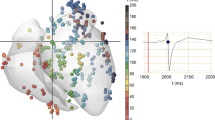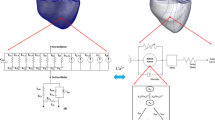Abstract
The application of strong electrical stimuli is a common method used for terminating irregular cardiac behaviour. The study presents the influence of electrophysiological heterogeneity on the response of human hearts to electrical stimulation. The human electrophysiology was simulated using the ten Tusscher-Noble-Noble-Panfilov cell model. The anisotropic propagation of depolarisation in three-dimensional virtual myocardial preparations was calculated using bidomain equations. The research was carried out on different types of virtual cardiac wedge. The selection of the modelling parameters emphasises the influence of cellular electrophysiology on the response of the human myocardium to electrical stimulation. The simulations were initially performed on a virtual cardiac control model characterised by electrophysiological homogeneity. The second preparation incorporated the transmural electrophysiological heterogeneity characteristic of the healthy human heart. In the third model type, the normal electrophysiological heterogeneity was modified by the conditions of heart failure. The main currents responsible for repolarisation (Ito, IKs and IKl) were reduced by 25%. Successively, [Na+]i was increased by the regulation of the Na+−Ca2+ exchange function, and fibrosis was represented by decreasing electrical conductivity. Various electrical stimulation configurations were used to investigate the differences in the responses of the three different models. Monophasic and biphasic electrical stimuli were applied through rectangular paddles and needle electrodes. A whole systolic period was simulated. The distribution of the transmembrane voltage indicated that the modification of electrophysiological heterogeneity induced drastic changes during the repolarisation phase. The results illustrated that each of the heart failure conditions amplifies the modification of the response of the myocardium to electrical stimulation. Therefore a theoretical model of the failing human heart must incorporate all the characteristic features.
Similar content being viewed by others
References
Akar, F. G., andRosenbaum, D. S. (2003): ‘Transmural electrophysiological heterogeneities underlying arrhythmogenesis in heart failure’,Circ. Res.,93, pp. 638–645
Al-Khadra, A., Nikolski, V., andEfimov, I. R. (2000): ‘The Role of electroporation in defibrillation’Circ. Res.,87, pp. 797–804
Aliev, R. R., andPanfilov A. V. (1995): ‘Multiple responses at the boundaries of vulnerability window in the BZ reaction’,Phys. Rev. E.,52, pp. 2287–2293
Antzelevitch, C., andSicouri, S. (1994): ‘Clinical relevance of cardiac arrhythmias generated by afterdepolarisations: Role of M-cells in the generation of U waves, triggered activity and torsade de pointes’,J. Am. Coll. Cardiol.,23, pp. 259–277
Carpenter, J., Rea, T. D., Murraya, J. A., Kudenchuk, P. J., andEisenberg, M. S. (2003): ‘Defibrillation waveform and post-shock rhythm in out-hospital ventricular fibrillation cardiac arrest’,Resuscitation,59, pp. 189–196
Clayton, R. H., andHolden, A. V. (2005): ‘Dispersion of cardiac action potential duration and the initiation of re-entry: A computational study’,BioMed. Eng.,4
De Mello, W. C. (1975): ‘Effect of intracellular injection of calcium and strontium on cell communication in the heart’,J. Physiol.,250, pp. 231–245
Factor, S. M., Sonnenblick, E. H., andKirk, E. S., (1978): ‘The histologic border zone of acute myocardial infraction-islands or peninsulas?’,Am. J. Pathol.,92, pp. 111–124
Furukawa, T., Myerburg, R. J., Furukawa, N., Bassett, A. L., andKimura, S. (1990): ‘Differences in transient outward currents of feline endocardial and epicardial myocytes’,Circ. Res.,67, pp. 1287–1291
Heddaya, A., andPark, K. (1994): ‘Mapping parallel iterative algorithms into workstation networks’,Technical Report BU CS 94 003, Boston, Massachusettes02215, pp. 135–142
Henriquez, C. S., Muzikant, A. L., andSmoak, C. K. (1996): ‘Anisotropy, fiber curvature and bath loading effects on activation in thin and thick cardiac tissue preparations: simulations in a three-dimensional bidomain model’,J. Cardiovasc. Electrophysiol.,7–5, pp. 424–444
Hooks, D. A., Tomlinson, K. A., Marsden, S. G., LeGrice, I. J., Smaill, B. H., Pullman, A. J., andHunter, P. J. (2002): ‘Cardiac microstructures: implications for electrical propagation and defibrillation in the heart’,Circ. Research,92–331
Kaab, S., Nuss, H. B., Chiamvimonvat, N., O'Rourke, B., Pak, P. H., Kass, D. A., Marban, E., andTomaselli, G. F. (1996): ‘Ionic mechanism of action potential prolongation in ventricular myocytes from dogs with pacing-induced heart failure’,Circ. Res.,78, pp. 262–273
Li, G. R., Lau, C. P., Ducharme, A., Tardif, J. C., andNattel, S. (2002): ‘Transmural action potential and ionic current remodelling in ventricles of failing canine hearts’,J. Physiol. Heart Circ. Physiol.,283–3, pp. H1031-H1041
Maurer, P., andWeingart, R. (1987): ‘Cell pairs isolated from adult guinea pig and rat hearts: effects of [Ca2+]i on nexal membrane resistance’,Pflügers Arch.,409, pp. 394–402
Näbauer, M., Beuckelmann, D. J., andErdmann, E. (1993): ‘Characteristics of transient outward current in human ventricular myocytes from patients with terminal heart failure’,Circ. Res.73, pp. 386–394
Peters, N. S., Green, C. R., Poole-Wilson, P. A., andSevers, N. J. (1996): ‘Reduced content of connexin43 gap junctions in ventricular myocardium from hypertrophied and ischemic human hearts’,Circulation,88, pp. 864–875.
Roth, B. J. (2000): ‘Influence of a perfusing bath on the foot of the cardiac action potential’,Circ. Res.,86
Sachse, F. B., Seemann, G., Chaisaowong, K., andWeiß, D. L. (2003): ‘Quantitative reconstruction of cardiac electromechanics in human myocardium: Assembly of electrophysiological and tension generation models’,J. Cardiovasc. Electrophysiol.,14–S10, pp. S210-S218
Shimizu, W., andAntzelevitch, C. (1997): ‘Sodium channel block with mexiletine is effective in reducing dispersion of repolarisation and preventing torsade de pointes in LQT2 and LQT3 models of the long-QT syndrome’,Circ.,96, pp. 2038–2047
Sommer, J. R. andJennings, R. B. (1992): ‘Ultrastructure of cardiac muscle’ in Raven Press, Ltd.: ‘The heart and cardiovascular system end 2’, (Raven press, Ltd, 1992), chap. 1, pp. 3–50
Streeter, D. D. (1979): ‘Gross morphologyand fiber geometry of the heart’, in Bethesda, B (Ed): ‘Handbook of physiology: the cardiovascular system, vol. I’ (American Physiology Society, 1979) pp. 61–112
Ten Tusscher, K. H. W. J., Noble, D., Noble, P. J., andPanfilov, A. V. (2004): ‘A model for human ventricular tissue’,Am. J. Physiol.,286, pp. H1573-H1589
Volders, P. G., Sipido, K. R., Carmeliet, E., Spatjens, R. L., Wellens, H. J., andVos, M. A. (1999): ‘Repolarizing K+ currents ITO1,-and IKS are larger in right than left canine ventricular myocardium’,Circ.,99, pp. 206–210
Wang, H. S., andCohen, I. S. (2003): ‘Calcium channel heterogeneity in canine left ventricular myocytes’,J. Physiol.,547, pp. 825–833
Weber, C. R., Piacentino, V., Houser, S. R., andBers, D. M., (2003): ‘Dynamic regulation of sodium/calcium exchange function in human heart failure’,Circulation,108, pp. 2224–2229
Author information
Authors and Affiliations
Corresponding author
Rights and permissions
About this article
Cite this article
Graf, I.M., Seemann, G., Weiß, D.L. et al. Influence of electrophysiological heterogeneity on electrical stimulation in healthy and failing human hearts. Med. Biol. Eng. Comput. 43, 783–792 (2005). https://doi.org/10.1007/BF02430958
Received:
Accepted:
Issue Date:
DOI: https://doi.org/10.1007/BF02430958





